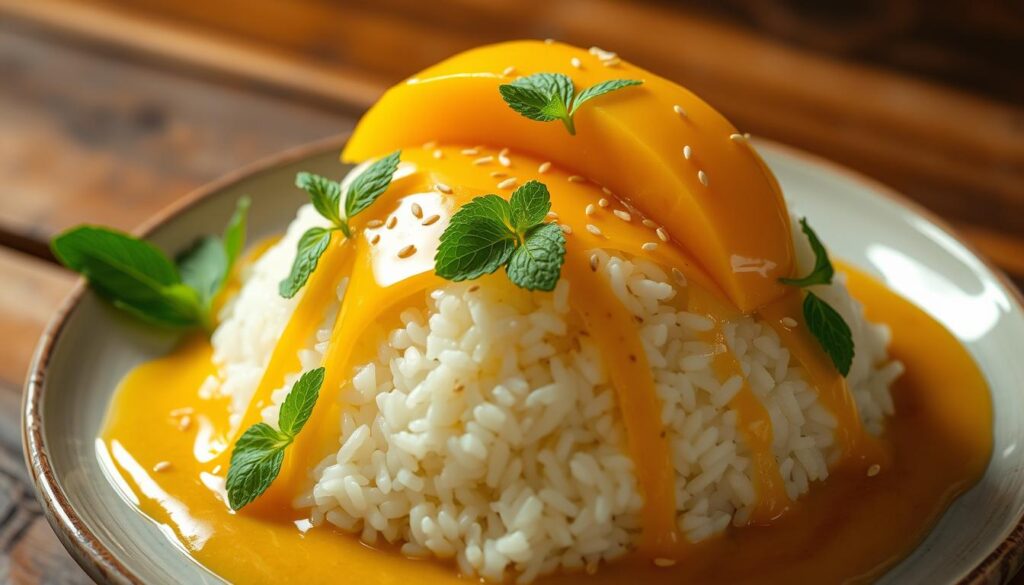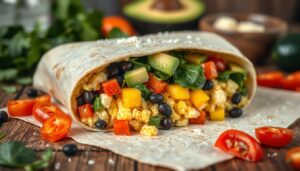I still remember my first bite of mango sticky rice. It was love at first taste. The sweet and creamy flavors in this dish are amazing. As I explored Thai cuisine, I learned that making mango sticky rice is an art.
It takes patience, practice, and the right techniques. In this article, I’ll share my journey of mastering this recipe. I’ll cover the cultural significance, essential ingredients, and how to prepare it step by step.
Whether you’re new to cooking or experienced, this guide will help you. I’ll cover everything from the basics to advanced techniques. So, let’s start and learn how to make perfectly creamy mango sticky rice.
Table of Contents
The Cultural Significance of Thai Mango Sticky Rice
Mango and sticky rice is a dessert deeply rooted in Thai culture. It’s often served at special occasions and festivals. This dish’s significance goes beyond its taste, showing Thai cuisine’s focus on balance and harmony.
The origins of mango sticky rice date back to ancient times. It became popular across Southeast Asia. In Thailand, it’s a comforting and indulgent dessert. The sweetness of mango pairs perfectly with the creamy sticky rice.
Origins of This Beloved Dessert
The history of mango sticky rice is fascinating. It shows the cultural exchange between Thailand and its neighbors. Today, it’s loved throughout Southeast Asia, with each country adding its own twist.
Why It’s Thailand’s Most Famous Sweet Dish
In Thailand, mango sticky rice is more than a dessert. It symbolizes hospitality and generosity. It’s served at gatherings and ceremonies, shared among friends and family.
Exploring mango and sticky rice’s cultural significance is important. It reminds us to value our culinary heritage. By doing so, we can appreciate Thai cuisine and the joy of sharing food.
Essential Ingredients for Authentic Mango Sticky Rice Recipe
To make a delicious mango sticky rice, you need the right ingredients. You’ll need glutinous rice, fresh mango, coconut milk, sugar, and salt. Each ingredient is key to getting the flavors and textures just right.
When picking ingredients for your mango sticky rice, keep these tips in mind:
- Glutinous rice, or sweet rice, is the base. Choose high-quality, fresh rice for the best results.
- Fresh mango is crucial. The mango type affects the flavor and texture. Opt for ripe, sweet mangoes in season.
- Coconut milk adds creaminess. You can use full-fat or low-fat coconut milk, based on your taste.
The quality of your ingredients greatly impacts the taste and texture of your dish. By using the right ingredients and following a traditional recipe, you’ll make a delicious dessert that will wow everyone.
Choosing and Ripening the Perfect Mangoes
Choosing the right mangoes is key for delicious mango sticky rice. I look for mangoes that are sweet and creamy, with a hint of tanginess. For thai mango sticky ric, I prefer Chaunsa or Alphonso mangoes. They have a rich flavor and smooth texture.
To check if mangoes are ripe, I look for a few signs. A ripe mango is slightly soft to the touch. It should have a sweet aroma and a yellow or orange color. I also check for any signs of bruising or spoilage.
After picking the perfect mangoes, I store them in a cool, dry place. This keeps them fresh for longer. It prevents over-ripening and keeps the mangoes sweet and creamy. By following these tips, I can make delicious mango sticky rice that impresses everyone.
Identifying the Best Mango Varieties
- Chaunsa: known for its rich flavor and smooth texture
- Alphonso: sweet and creamy, with a hint of tanginess
- Ataulfo: sweet and slightly spicy, with a unique flavor profile
Ripeness Indicators
A ripe mango is slightly soft to the touch. It has a sweet aroma and a yellow or orange color. I also check for any signs of bruising or spoilage.
Understanding Glutinous Rice: The Foundation of Success
To make a great mango glutinous rice recipe, knowing about glutinous rice is key. This rice is the base of the dish. Cooking it just right is essential for success. Short-grain glutinous rice works best because it has more starch than long-grain rice.
When making glutinous rice for your mango dish, rinse it well and soak it in water for at least 4 hours. This removes extra starch and helps the rice cook evenly. Then, drain and steam the rice until it’s soft and fluffy.
Here are some important tips for cooking glutinous rice for your mango dish:
- Use a 1:1 ratio of rice to water
- Soak the rice for at least 4 hours
- Steam the rice for 15-20 minutes
- Let the rice cool before mixing it with the mango and coconut cream sauce
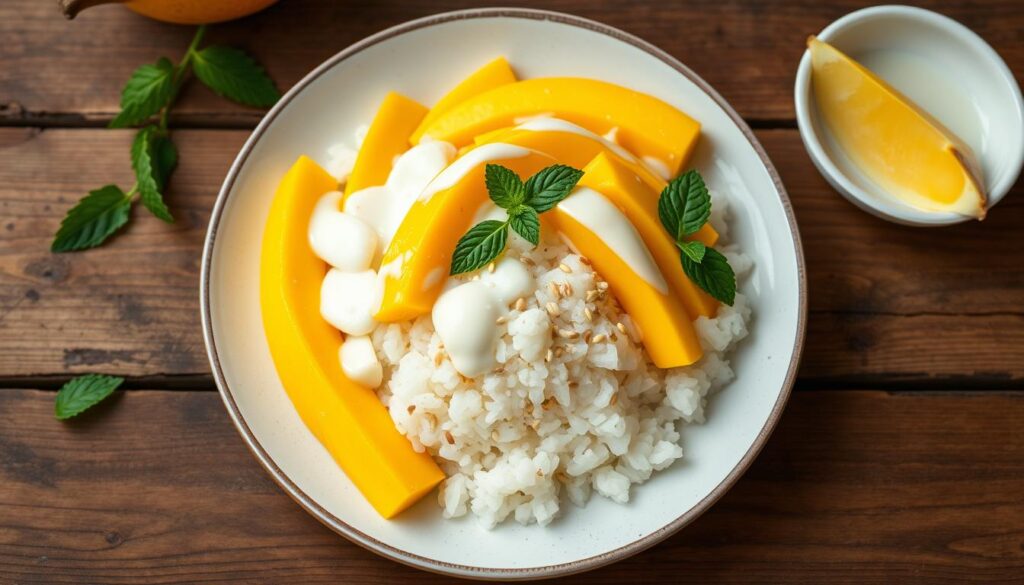
By following these tips and using the right glutinous rice, you’re on your way to a tasty mango glutinous rice recipe. Always use fresh, high-quality ingredients. Feel free to try different variations to find your favorite flavor.
My Secret Coconut Cream Sauce Formula
To make a true mango sticky rice, the coconut cream sauce is key. I’ve worked on my secret formula for years. It’s a big improvement for this Thai dessert. The sauce mixes all the flavors together beautifully.
For a great coconut cream sauce, use top-notch ingredients and the right amounts. Here’s what you need:
- 1 can of full-fat coconut milk
- 2 tablespoons of granulated sugar
- 1/4 teaspoon of salt
- 1/2 teaspoon of vanilla extract
Ingredient Proportions
Getting the ingredients in the right mix is crucial. Use a 2:1 ratio of coconut milk to sugar. This makes the sauce creamy but not too sweet.
Cooking Techniques
To make the sauce, mix the ingredients in a saucepan. Heat it over low heat, stirring constantly. This stops the sauce from burning or sticking.
Achieving the Perfect Consistency
The sauce should be thick and creamy but still pourable. Cook it for 10-15 minutes. This makes it slightly thicker and gives your dessert a velvety feel.
| Ingredient | Quantity | Importance |
|---|---|---|
| Coconut milk | 1 can | High |
| Granulated sugar | 2 tablespoons | Medium |
| Salt | 1/4 teaspoon | Low |
Step-by-Step Mango Sticky Rice Preparation Method
To make sticky rice and mango, also known as thai mango sticky ric, follow a few easy steps. First, rinse the glutinous rice well and soak it in water for at least 4 hours. Then, drain the water and steam the rice until it’s fluffy.
While the rice cooks, prepare the coconut cream sauce. Mix coconut milk, sugar, and salt together. Heat the mixture over low heat until it thickens. Once ready, slice the mango and place it on a platter with the sticky rice.
Here are the steps to follow:
- Rinse and soak the glutinous rice
- Steam the rice until it is cooked and fluffy
- Prepare the coconut cream sauce
- Slice the mango and arrange it on a serving platter with the sticky rice and mango
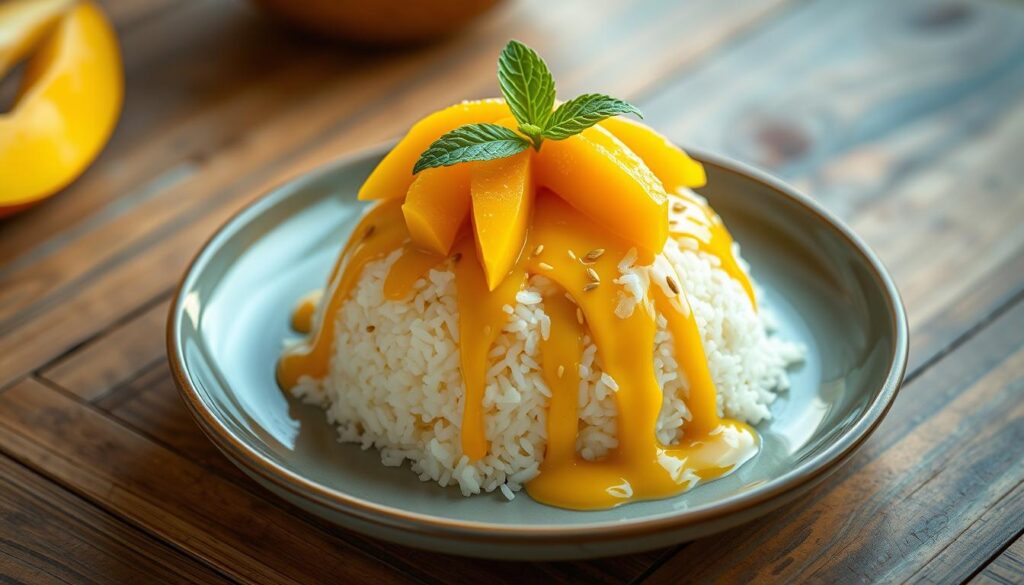
By following these steps, you can make a delicious thai mango sticky ric dish. It’s sure to impress your friends and family. Use fresh mango and real coconut milk for the best flavor and texture.
Essential Equipment Needed for Perfect Results
To make the perfect mango sticky rice, you need the right tools. Traditional items like a steamer basket are key. Modern tools, like a rice cooker, also play a big role. The equipment you use can greatly affect the taste and texture of your dish.
Here are some must-haves:
- A large pot with a heavy bottom for cooking the glutinous rice
- A steamer basket for steaming the rice and mango
- A rice cooker for easy and convenient cooking
- A saucepan for preparing the coconut cream sauce
Having the right equipment makes cooking mango sticky rice easy and fun. Choose tools that are easy to clean and maintain. This will make your cooking experience better and more efficient.
Quality ingredients are also crucial for a great mango sticky rice. Fresh, high-quality mangoes and glutinous rice make a big difference. They ensure your dish tastes amazing.
| Equipment | Purpose |
|---|---|
| Steamer basket | Steaming the rice and mango |
| Rice cooker | Cooking the glutinous rice |
| Saucepan | Preparing the coconut cream sauce |
Common Mistakes to Avoid When Making Mango Sticky Rice
When making mango sticky rice, knowing common mistakes is key. These errors can ruin the dish’s quality. To make a great mango sticky rice, getting the right texture is crucial.
Common mistakes include overcooking the rice, making it mushy. Also, using underripe mangoes can make the dish too tart. The wrong rice or cooking methods can also mess up the dish.
- Using old or low-quality glutinous rice
- Not soaking the rice long enough
- Overmixing the coconut cream sauce
- Serving the dish at the wrong temperature
By avoiding these mistakes, you can make a delicious mango sticky rice. It’s all about paying attention to detail and knowing your ingredients and techniques. Whether you’re using sticky rice and mango or mango and sticky rice, success comes from careful preparation.
| Mistake | Effect on Dish |
|---|---|
| Overcooking the rice | Mushy texture |
| Underripe mangoes | Tart and firm texture |
| Incorrect cooking technique | Less-than-desirable texture and flavor |
Avoiding these mistakes will make your mango sticky rice stand out. With practice, you’ll get better at making this Thai dessert. Your creations will impress everyone.
Creative Serving Suggestions and Garnishes
Presenting thai mango sticky ric is as key as its taste. To make this dessert stand out, try creative garnishes and serving ideas. Mango sticky rice looks great in small bowls or cups, perfect for a quick snack.
Here are some creative ways to serve mango sticky rice:
- Serve it in mango skins for a burst of color and flavor.
- Add toasted coconut flakes or chopped nuts for crunch.
- Drizzle with honey or palm sugar for a sweet touch.
- Top with fresh mint leaves or edible flowers for elegance.
With a little creativity, your thai mango sticky ric will be unforgettable. It’s perfect for dinner parties or a cozy night at home. Mango sticky rice is always a crowd-pleaser.
| Garnish | Description |
|---|---|
| Toasted coconut flakes | Adds a sweet and crunchy texture to the dish |
| Chopped nuts | Provides a satisfying crunch and added flavor |
| Fresh mint leaves | Adds a bright and refreshing flavor to the dish |
Make-Ahead Tips and Storage Guidelines
When making a mango sticky rice recipe, think about how to keep it fresh and tasty. You can prepare it ahead of time. This way, you can enjoy it whenever you want.
To keep mango sticky rice fresh, use airtight containers. Here are some tips:
- Store the cooked rice in a sealed container in the refrigerator for up to 3 days.
- Freeze the cooked rice for up to 2 months and reheat it when needed.
- Keep the coconut cream sauce separate from the rice to prevent sogginess.
Reheating mango sticky rice is easy. Just microwave it for 30-45 seconds or heat it on the stovetop with a bit of water. When reheating, do it gently to avoid mushy rice.
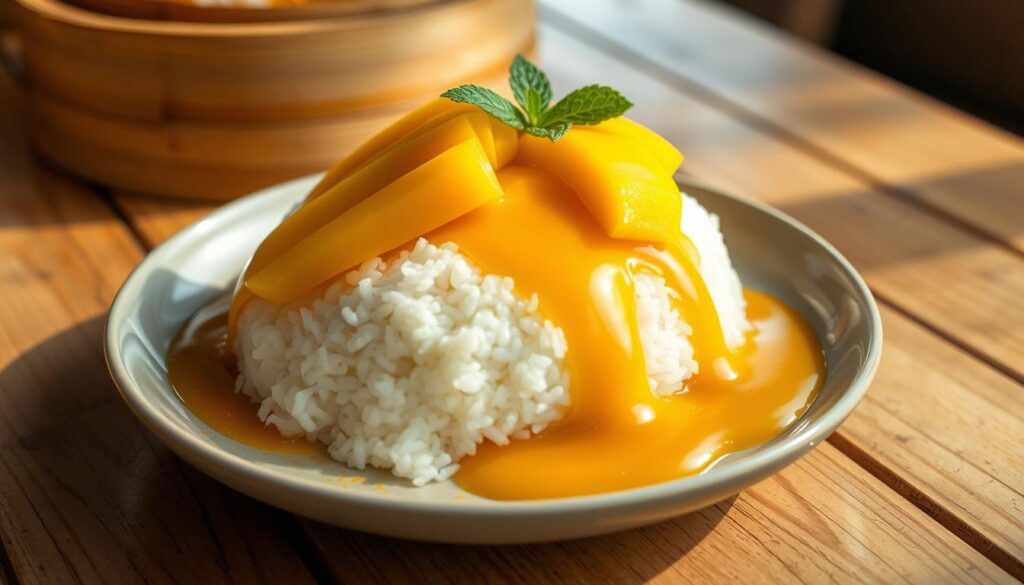
By following these tips, you can enjoy your mango sticky rice recipe even after preparing it ahead. Whether you’re using a mango glutinous rice recipe or a traditional one, proper storage and reheating are key. They help keep the dish’s texture and flavor perfect.
| Storage Method | Shelf Life |
|---|---|
| Refrigeration | Up to 3 days |
| Freezing | Up to 2 months |
Seasonal Adaptations and Variations
Exploring mango and sticky rice has shown me its versatility. This dish can change with the seasons and dietary needs. The mango and sticky rice combo is timeless, but trying new fruits and tweaks is exciting.
For a summer twist, swap mangoes for peaches or pineapples. This adds a sweet and refreshing flavor. In fall, apples or pears make the dish warm and cozy.
Alternative Fruit Options
- Pineapples: a sweet and tangy alternative to mangoes
- Peaches: a juicy and flavorful option for summer
- Apples: a warm and comforting choice for fall
Modifying mango sticky rice for different diets is easy. Use coconut sugar for a vegan version. For those with gluten intolerance, try gluten-free sticky rice.
Dietary Modifications
- Coconut sugar: a vegan-friendly alternative to refined sugar
- Gluten-free sticky rice: a option for those with gluten intolerance
Trying new fruits and dietary changes makes mango sticky rice unique and tasty. Whether you stick with mango or try something new, the fun is in experimenting. Enjoy the process and be creative in the kitchen.
| Fruit Option | Season | Dietary Modification |
|---|---|---|
| Mangoes | Summer | Vegan-friendly |
| Pineapples | Summer | Gluten-free |
| Apples | Fall | Vegan-friendly |
Troubleshooting Your Mango Sticky Rice
When making mango sticky rice, things don’t always go as planned. To rescue your dish, it’s essential to identify common problems and apply the right troubleshooting tips. Some issues you might encounter include overcooked or undercooked thai mango sticky ric, unevenly cooked rice, or a sauce that’s too thick or too thin.
To address these problems, consider the following tips:
- Adjust your cooking time and temperature to achieve the perfect texture for your mango sticky rice.
- Use the right type and amount of coconut milk to create a smooth and creamy sauce.
- Don’t overmix the rice and sauce, as this can lead to an unappetizing texture.
By following these tips and being mindful of the potential pitfalls, you can create a delicious and authentic thai mango sticky ric dish that’s sure to impress. Remember to stay calm and patient, as troubleshooting is all about finding the right solutions to common problems.
Conclusion: Mastering the Art of Thai Mango Sticky Rice
Making the perfect mango sticky rice recipe is an art. It needs careful attention to every detail. From picking the ripest mangoes to getting the right texture in the mango glutinous rice, each step is key.
Now, you have the knowledge to make this beloved Thai dessert at home. Remember, practice and patience are the keys to mastering mango sticky rice. Don’t worry if your first try isn’t perfect.
Try new things, experiment with different flavors, and enjoy every bite. By following what you’ve learned, you’ll impress everyone with your delicious Thai mango sticky rice.
So, get some fresh mangoes, start your steamer, and let’s cook! Bon appetit, and happy dessert making.
